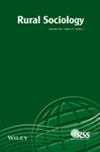无处可去:COVID-19 大流行期间西班牙裔占多数的农村地区的住房不安全问题☆。
IF 1.9
3区 社会学
Q2 SOCIOLOGY
引用次数: 0
摘要
新墨西哥州北部在 COVID-19 大流行及其后果面前具有独特的脆弱性。新墨西哥州以西班牙裔人口居多,人口老龄化严重,医疗保健服务减少,这些因素使美国这一地区的许多社区面临风险。陶斯县受 COVID-19 影响的风险尤其高。由于对旅游业的依赖,该县也更容易受到大流行病的经济后果的影响;这意味着对个别家庭造成了重大影响。随着失业率和贫困率的上升以及大流行病救助计划的推出陷入困境,这些后果意味着许多家庭的生活岌岌可危。大流行病最明显的影响之一就是无法获得负担得起的住房。本文基于 58 次深入访谈和 5 个月的参与观察,探讨了大流行期间本已脆弱的人群无家可归和住房无保障的经历,说明了许多人挣扎的方式。重要的是,本文探讨了 COVID-19 大流行期间农村白人和农村西班牙裔参与者住房不安全模式的差异。此外,本文还主张必须研究农村地区处理住房不稳定问题的细微模式,因为不同人群的应对方式会影响住房成为问题时所需的帮助形式。本文章由计算机程序翻译,如有差异,请以英文原文为准。
Nowhere Else to Go: Housing Insecurity in a Hispanic-Majority Rural County During the COVID-19 Pandemic☆
Northern New Mexico was uniquely vulnerable to the COVID-19 pandemic and its fallout. Its Hispanic majority, aging population, and decreased access to healthcare put many of the communities in this area of the United States at risk. Taos County was particularly at increased risk of impact from COVID-19. The county was also more vulnerable to the economic consequences of a pandemic due to reliance on tourism; this meant major impacts for individual households. As unemployment and poverty increased—and pandemic relief program rollouts floundered—the consequences meant precarity for many families. One of the most visible impacts of the pandemic was the inability to access affordable housing. This paper, based on 58 in-depth interviews and 5 months of participant observation, explores experiences of homelessness and housing insecurity among an already vulnerable population during the pandemic, illustrating the ways in which many people struggled. Importantly, this paper explores differences in patterns of housing insecurity among rural White and rural Hispanic participants during the COVID-19 pandemic. In addition, this paper advocates the importance of looking at nuanced patterns of dealing with housing precarity in the rural setting as the ways in which different populations cope impact the forms of help that are needed when housing becomes a problem.
求助全文
通过发布文献求助,成功后即可免费获取论文全文。
去求助
来源期刊

RURAL SOCIOLOGY
SOCIOLOGY-
CiteScore
4.60
自引率
13.00%
发文量
47
期刊介绍:
A forum for cutting-edge research, Rural Sociology explores sociological and interdisciplinary approaches to emerging social issues and new approaches to recurring social issues affecting rural people and places. The journal is particularly interested in advancing sociological theory and welcomes the use of a wide range of social science methodologies. Manuscripts that use a sociological perspective to address the effects of local and global systems on rural people and places, rural community revitalization, rural demographic changes, rural poverty, natural resource allocations, the environment, food and agricultural systems, and related topics from all regions of the world are welcome. Rural Sociology also accepts papers that significantly advance the measurement of key sociological concepts or provide well-documented critical analysis of one or more theories as these measures and analyses are related to rural sociology.
 求助内容:
求助内容: 应助结果提醒方式:
应助结果提醒方式:


